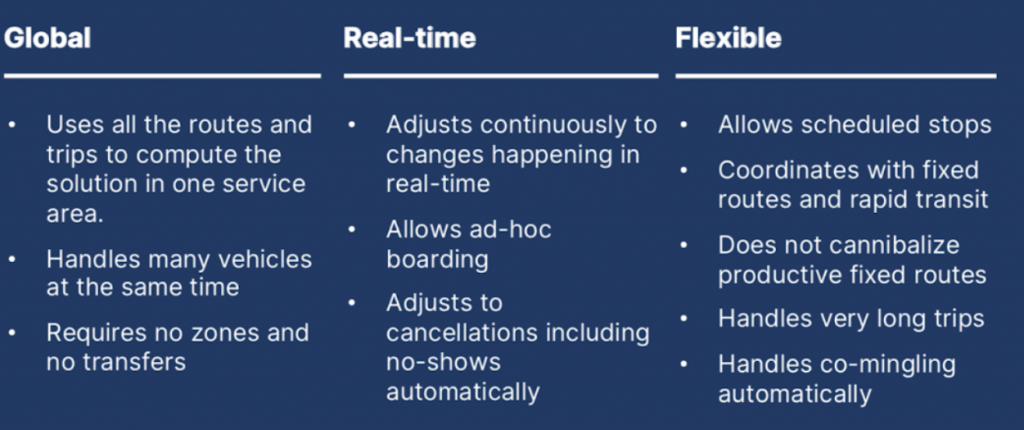What comes to mind when you think of “on-demand transit”? On-demand transit refers to a system where passengers schedule pick-up and drop-off locations and times, typically through smartphones. The transit agency vehicles, guided by on-demand software platforms, then transport these passengers without adhering to predetermined routes. While services like Uber or Lyft might be the first examples that come to mind, they only scratch the surface of the diverse range of on-demand transit solutions available.
This guide will answer the following questions:
- What challenges commonly arise in on-demand transit systems?
- How do routing algorithms influence the implementation of on-demand transit services?
- What are the various routing algorithms and their specific uses?
- Which routing algorithm strikes the optimal balance between operational efficiency and rider convenience?
- How can one identify the type of algorithm employed in a transit system?
- In what ways do leading transit agencies leverage advanced on-demand transit software for optimal routing solutions?
- What key inquiries should be made when evaluating potential on-demand transit software vendors?

Revolutionizing Transit through On-Demand Software
- Routing Algorithms & Parameters
- Service Configuration
- Service Administration
- Rider Management
- Ride Management
- Booking Methods
- Dispatch
- Driver Management
- Vehicle Configuration
- Scheduling
- And many other functions
Issues Associated with Standard On-Demand Deployment Models
Typically, on-demand transit services are introduced in stages, beginning with the selection of a small area for a transit pilot that employs a single vehicle. Following the pilot phase, the agency assesses its performance, deciding whether to expand to a larger area with more vehicles based on the insights gained. This phased approach aims to gauge the functionality of the on-demand transit system and its ability to meet rider demand while allowing for issue resolution before potential expansion or discontinuation if performance is subpar.
However, challenges arise with this method. For instance, if the service area surpasses the capacity of a single vehicle, complications arise. Many on-demand platforms utilize distinct routing algorithms for managing multiple vehicles, leading to variations in service characteristics and outcomes between single-vehicle and multi-vehicle service areas. Additionally, relying on a small-scale transit model like the one-vehicle phase can pose difficulties in planning for long-term service.
The Rider Experience is Shaped by Routing Algorithms
Routing algorithms serve as the “secret sauce” in the software, playing a crucial role in determining the performance of an on-demand service. These algorithms effectively allocate requested trips to vehicles, minimizing violations such as lateness, extended ride times, and transfers.
The routing algorithm affects:
- Booking policy
- Cancellation policy
- Size of the service area
- Number of riders serviced per hour
- Number of transfers required
- Number of vehicles on the road
- Coordination with other services
Three Major Routing Algorithm Properties
- Vehicles: How many vehicles can the routing algorithm handle in one area?
- Rides: How many rides can the algorithm handle at one time?
- Real-time: How well can the algorithm handle sudden changes at any time, including right now?
A superior routing algorithm combines convenience and efficiency.
The transit agency’s objective is to enhance the rider experience using existing or reduced assets. State-of-the-art routing algorithms excel in generating routes that efficiently serve numerous riders per hour, ensuring swift and dependable service.
The optimal algorithm:
- Consistently generates effective routes
- Minimizes wait times and trip durations for riders
- Reduces the need for transfers, even when coordinating with established fixed routes or rapid transit systems
- Strategically deploys a sensible number of vehicles, enabling the simultaneous service of multiple riders to enhance operational efficiency and route productivity.
Different Routing Algorithms And Their Applications
The following descriptions delineate the diverse standard algorithms employed in software platforms and their associated characteristics. Utilize this information to align performance goals with your on-demand project objectives and desired outcomes. Enhance your software selection process by incorporating this knowledge and posing more informed questions.
One-Vehicle Routing Algorithms
Do Nothing Algorithm, also known as Brute Force
A “Do Nothing” or “Brute Force” algorithm assigns trips randomly to the route or manages them in a first-come-first-served manner, adding new ride requests to the end of the queue.
Performance considerations include:
- Trip processing (typically up to 5 trips per hour max)
- Cancellations and no-shows are hard to control and worsen route quality and customer experience
- Only accommodates ASAP trips
Best Position Algorithm
Performance considerations include:
- Handles the first few rides well, but the route quality and customer experience deteriorates quickly
- Cancellations and no-shows are hard to manage and degrade route quality
- Works best for short service or very few rides
Greedy Algorithm
A “Greedy Algorithm” chooses the closest stop to the current stop as the next stop. Although it works better than the Brute Force and Best Position options, it cannot handle requested times well. All trips are ASAP, so the rider cannot plan a journey, for instance, commuting home from work.
Concerns include:
- Handles a few trips per hour (up to 5 trips per hour)
- Hard to handle a specific request time
- Forces all trips to be ASAP
- Cancellations and no-shows are hard to handle
Traveling Salesperson Problem-Solver (TSP) Algorithm
A fast-running TSP is the best solution for routing with one vehicle. TSPs create the best quality routes because they constantly seek the “least worst” routing options. In addition, great TSPs are fast enough to handle real-time events, including ad hoc boarding.
Characteristics include:
- An effective TSP solver can handle more than ten rides per hour
- Needs to be real-time implementation, or it can’t handle cancellations well
- Needs to run fast to accommodate more than a couple of rides
Multi-Vehicle Routing Algorithms
A multi-vehicle routing algorithm is necessary when:
The service area is large;
many vehicles are needed to meet the demand for service; and
the demand for service is over five trips per hour
Insert to Best Vehicle Algorithm
The “Insert to Best Vehicle” algorithm is a scaled version of the one-vehicle “Best Position” algorithm applied to multiple routes. The “Best Position” algorithm runs on every route. It then chooses the route that provides the best overall transit solution. Next, the software adds the requested trip to the vehicle in the best position to accommodate that particular trip and at the trip booking time.
Concerns include:
- Route quality and customer experience deteriorates very quickly
- Handles cancellations and no-shows poorly
- Can’t move trips from vehicle to vehicle
This algorithm has the same limitation as the Best Position algorithm — adding rides degrades the route quality quickly. Therefore, the number of rides per hour that this algorithm can handle is not consistent.
Real-time Global Optimization Algorithm
The “Right Way” To Optimize A Route
The “Real-time Global Optimization” algorithm continuously optimizes the entire fleet and all the trips, dynamically and in real-time. It results in the most effective on-demand service convenient for the rider and efficient for the transit agency.
Benefits include:
- Can move trips from vehicle to vehicle
- Route quality and customer experience is always good
- Handles cancellations and no-show very well
- Service areas can be any size (as long as there are enough vehicles to service the area)
- Vehicle capacity can be any size

A Real-time Global Routing Optimization algorithm can handle small or large service areas with many vehicles, riders, and trips. Riders can request trips and make changes, in advance and in real-time, including accommodating ad hoc boarding by riders hailing a vehicle.
The algorithm swiftly adapts to any changes and remains minimally affected by cancellations, no-shows, and detours. Additionally, riders experience seamless travel without the need for transfers, as the algorithm enables vehicles to navigate freely and optimally within a broad service area, ensuring a positive customer experience by eliminating frustration and time wastage.
Moreover, the Real-time Global Routing Optimization algorithm exhibits flexibility in coordinating with fixed routes and rapid transit services. It seamlessly integrates with scheduled stops, creating an optimal urban route configuration. This configuration involves fixed routes catering to consistent and dense demand, complemented by real-time, on-demand services in surrounding areas to address dynamic and uncertain needs.
